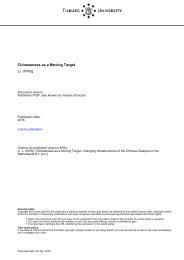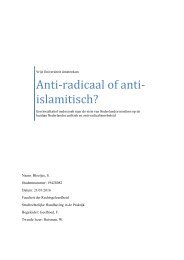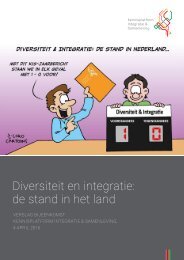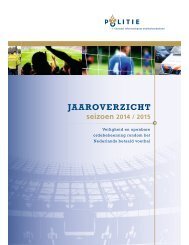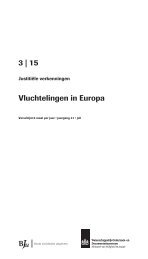fra-2014-being-trans-eu-comparative_en
fra-2014-being-trans-eu-comparative_en
fra-2014-being-trans-eu-comparative_en
You also want an ePaper? Increase the reach of your titles
YUMPU automatically turns print PDFs into web optimized ePapers that Google loves.
Viol<strong>en</strong>ce and harassm<strong>en</strong>tFigure 45: Reporting incid<strong>en</strong>ts of the last and most serious hate‐motivated harassm<strong>en</strong>t to the police,by type of incid<strong>en</strong>t (%)EU <strong>trans</strong> averageName callingBullyingRidiculingOther verbal insult, abuse, humiliationExcessive /constant negative comm<strong>en</strong>tsAggressive gesturesIsolation from something or somebody; ignoringOther non-verbal insult, abuse, humiliationOther6889910678107971189811814Most rec<strong>en</strong>t incid<strong>en</strong>tof harassm<strong>en</strong>t inthe 12 monthspreceding the surveyMost serious incid<strong>en</strong>tof harassm<strong>en</strong>t inthe five yearspreceding the surveyQuestions:Base:0 10 20 30 40 50FB1_5. Do you think the LAST incid<strong>en</strong>t of harassm<strong>en</strong>t in the past 12 months happ<strong>en</strong>ed partly or completely because youwere perceived to be <strong>trans</strong>g<strong>en</strong>der? Yes.FB2_5. Do you think this incid<strong>en</strong>t of harassm<strong>en</strong>t happ<strong>en</strong>ed partly or completely because you were perceived to be [categoryon the basis of A3 or A4]? ‘Yes’.FB1_11., FB2_11. Did you or anyone else report it to the police? Yes.FB1_4., FB2_4. Thinking about the LAST incid<strong>en</strong>t of harassm<strong>en</strong>t, what happ<strong>en</strong>ed to you?Trans respond<strong>en</strong>ts in the EU LGBT survey who were harassed in the 12 months (last incid<strong>en</strong>t) or five years (most seriousincid<strong>en</strong>t) preceding the survey in part or <strong>en</strong>tirely because they were perceived to be <strong>trans</strong>.Source: FRA, EU LGBT survey, 2012one in four feared a homophobic or <strong>trans</strong>phobic reactionfrom the police.Again, emotional reasons are important to understandnon‐reporting: over one in five (last incid<strong>en</strong>t) andalmost one in four (most serious incid<strong>en</strong>t) was ashamed,embarrassed and/or didn’t want anyone to know. Onein 10 was too emotionally upset to contact the police.Reporting to other organisationsVictims were asked if they or anyone else reported thehate‐motivated incid<strong>en</strong>t to other organisations or institutions,namely an NGO, an LGBT organisation, a g<strong>en</strong>eralvictim support organisation, a state or national institutionsuch as an equality body, a hospital or other medicalservice, a rape crisis c<strong>en</strong>tre, an internet provider oranother organisation.As regards both the last hate‐motivated incid<strong>en</strong>ts andthe most serious hate‐motivated incid<strong>en</strong>ts,only 16 %were reported to one of these organisations or institutions(Table 12). This is lower than the perc<strong>en</strong>tageof respond<strong>en</strong>ts who reported hate‐motivated attacksor threats to other organisations, but still higher thanthe reporting rate of hate‐motivated harassm<strong>en</strong>t tothe police.Wh<strong>en</strong> respond<strong>en</strong>ts did report incid<strong>en</strong>ts of hate‐motivatedharassm<strong>en</strong>t to organisations other than the police,this most oft<strong>en</strong> involved an LGBT organisation (56 % forthe most rec<strong>en</strong>t and 53 % for the most serious incid<strong>en</strong>t).Around one in 10 reported to a state or national institution,such as an equality body, and/or to g<strong>en</strong>eral victimsupport organisation, and/or a hospital or other medicalservice and/or an internet provider. Almost one infive w<strong>en</strong>t to a NGO and almost one in four to anotherorganisation. The respond<strong>en</strong>ts could have reported theincid<strong>en</strong>ts to multiple organisations, and therefore in thesurvey they were able to select multiple options fromthe list of organisations (Table 13).2.4.4. Avoidance behaviour“Repeatedly I experi<strong>en</strong>ce wh<strong>en</strong> I am traveling with mypartner, vulgarities, suggestive remarks, threats, not onlywh<strong>en</strong> we hold hands sometimes, but ev<strong>en</strong> wh<strong>en</strong> we ’only’walk side by side. We do dress inconspicuously. Sometimeswe are forced to change out int<strong>en</strong>ded path to avoidcertain streets or squares. The lat<strong>en</strong>t fear, to become ’th<strong>en</strong>eighbourhood fagots’, forces us to avoid physical clos<strong>en</strong>essin public. This d<strong>en</strong>ial of our feelings burd<strong>en</strong>s me greatly.”(Trans man, 39, Germany)In addition to g<strong>en</strong>eral safety concerns experi<strong>en</strong>ced bymany members of the LGBT community, <strong>trans</strong> peoplemay fear assault, threat or harassm<strong>en</strong>t specificallybecause of their <strong>trans</strong> id<strong>en</strong>tity. One third of all <strong>trans</strong>respond<strong>en</strong>ts (32 %) avoid expressing their g<strong>en</strong>der (ortheir desired g<strong>en</strong>der) through physical appearance andclothing because of such fears. In addition, half of therespond<strong>en</strong>ts (50 %) indicate that these fears also leadthem to avoid certain places or locations (Figure 46).69




